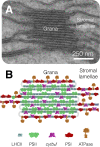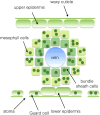Photosynthesis
- PMID: 27784776
- PMCID: PMC5264509
- DOI: 10.1042/EBC20160016
Photosynthesis
Erratum in
-
Correction: Photosynthesis.Essays Biochem. 2017 Oct 31;61(4):429. doi: 10.1042/EBC20160016_COR. Print 2017 Oct 31. Essays Biochem. 2017. PMID: 29089380 Free PMC article. No abstract available.
Abstract
Photosynthesis sustains virtually all life on planet Earth providing the oxygen we breathe and the food we eat; it forms the basis of global food chains and meets the majority of humankind's current energy needs through fossilized photosynthetic fuels. The process of photosynthesis in plants is based on two reactions that are carried out by separate parts of the chloroplast. The light reactions occur in the chloroplast thylakoid membrane and involve the splitting of water into oxygen, protons and electrons. The protons and electrons are then transferred through the thylakoid membrane to create the energy storage molecules adenosine triphosphate (ATP) and nicotinomide-adenine dinucleotide phosphate (NADPH). The ATP and NADPH are then utilized by the enzymes of the Calvin-Benson cycle (the dark reactions), which converts CO2 into carbohydrate in the chloroplast stroma. The basic principles of solar energy capture, energy, electron and proton transfer and the biochemical basis of carbon fixation are explained and their significance is discussed.
Keywords: membrane; photosynthesis; thylakoid.
© 2016 The Author(s).
Figures



















Comment in
-
Editorial Note: Photosynthesis.Essays Biochem. 2021 Jul 26;65(2):405. doi: 10.1042/EBC-2016-0016C_EDN. Epub 2021 Jul 16. Essays Biochem. 2021. PMID: 34309653 Free PMC article. No abstract available.
References
-
- Blankenship R.E. Molecular Mechanisms of Photosynthesis. Chichester: Wiley–Blackwell Publishing; 2014.
Publication types
MeSH terms
Substances
LinkOut - more resources
Full Text Sources
Other Literature Sources

